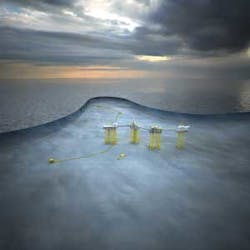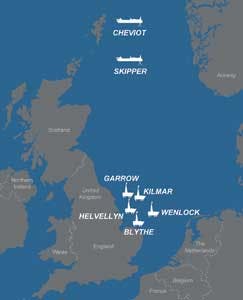Statoil and its partners have agreed on a development concept for Johan Sverdrup in the central NorwegianNorth Sea. The project, potentially Norway's largest since the 1980s, will deliver production of 550,000 boe/d at peak and the facilities could remain in service for 50 years.
Under the proposed first phase - the final development plan will be submitted to Norway's parliament next year - the partners will commission a four-platform field center to be installed in 120 m (393 ft) of water, with design capacity of 315,000 boe/d. According to Lundin Petroleum, 45 production and injection wells will be drilled in Phase 1, with a semisubmersible rig drilling 11-17 wells prior to first oil in late 2019. New long-distance subsea trunklines will take the oil and gas respectively to Mongstad and Kaarstø on Norway's southwest coast.
The complex's 80-MW power supply will come from a shore-based transformer at Kaarstø delivering direct current to a converter on the riser platform. Over later phases, power from shore could be extended to otherfield developments in the area, once requirements have been established.
Statoil estimates first-phase investments in the range $16.4-19.8 billion, although work continues to find ways to lower costs. The partners have not yet addressed the scope and costs of future phases, although their long-term goal is to achieve a 70% recovery rate from the field.
Johan Sverdrup extends over 200 sq km (77 mi) in licenses PL265, PL501, and PL502.
Reserves boost for Skarfjell
Wintershall has doubled the potential resources at the Skarfjell field in the Norwegian North Sea to 120-230 MMboe. This follows analysis of an appraisal well and side track which proved oil and gas in Jurassic sandstones a short distance south of the discovery well. No further drilling should be needed, the company said, and studies have started for a development. Options include a standalone project and a tieback to the GDF Suez-operated Gjoa platform 15 km (9.3 mi) to the northeast.
Last year, exploration activity offshore Norway was highest in the North Sea, according to the Norwegian Petroleum Directorate (NPD). Wells proved seven oil and gas accumulations, with seven discoveries in the Norwegian Sea and five in the Barents Sea. NPD estimates cumulative recoverable reserves at 50-106 MMcm of oil and 30-58 bcm of gas.
Currently 13 Norwegian fields are under development and NPD expects operators to submit plans for a further 13 projects over the next two years. Investments across the Norwegian shelf could rise by $487 million this year to $28.5 billion, it adds.
Norway allocates more blocks
Norway's government has offered 65 new production licenses to a total of 48 companies under the 2013 Pre-defined Areas (APA) licensing round. Of these, 38 are in the North Sea, 19 in the Norwegian Sea and eight in the Barents Sea. Seventeen rank as acreage additional to existing licenses.
NPD says interest was greatest in the northern Norwegian North Sea and in the central Norwegian Sea. This was probably down to familiarity with the geology in the area, said exploration director Sissel Eriksen, and a general desire to maximize tie-ins of resources to offshore infrastructure.
Britain has opened the bidding for the UK's 28th offshore licensing round, with Energy Minister Michael Fallon reaffirming the government's goal to fully extract remaining reserves of potentially up to 20 Bbbl. Oonagh Werngren, operations director of Oil & Gas UK, hopes that more new applicants would participate, alongside the established players, with the sector in need of a revival. UK offshore production continues to slide, and reserves are not being replaced. A mere 15 exploration wells were drilled in UK waters last year, Werngren said, and less than 100 MMboe have been discovered over the past two years.
ATP UK back in business
Alpha Petroleum, a subsidiary of Petroleum Equity, has acquired ATP Oil & Gas UK for $133 million. Parent company ATP Corp. filed for protection in 2012 under Chapter 11 of the US Bankruptcy Code and had been looking to sell the UK business, which includes operated gasfields in the southern North Sea.
The deal clears ATP UK of all debts and leaves the company free to resume work on undeveloped assets. One of these is the Cheviot field in the northern UK North Sea, which has in-place oil of over 200 MMbbl. Management had commissioned an Octabuoy semisubmersible drilling, production, and storage platform designed by Moss Maritime to accommodate dry wellheads. Cosco in China had started construction, but the program has been cancelled due to the high costs. Instead, ATP UK and its new owners will examine alternatives, most likely an FPSO, and will seek to reduce costs via a farm-out of the license.
Another troubled North American independent, Antrim Energy, is selling its UK North Sea subsidiary to First Oil Expro for $53 million. This follows problems related to financing of the Causeway field subsea tieback to the North Cormorant platform, which were compounded when the platform had to be shut down last September.
First oil flows from Amstel
GDF Suez has started production fromAmstel, its first oilfield development in the Dutch North Sea. Oil is produced through the Q13a-A platform and transported through a new 25-km (15.5-mi) subsea pipeline to TAQA's P15 platform to the northwest. At peak, Amstel should deliver 15,000 b/d of oil, with a production life estimated at 10 years.
About the Author
Jeremy Beckman
Editor, Europe
Jeremy Beckman has been Editor Europe, Offshore since 1992. Prior to joining Offshore he was a freelance journalist for eight years, working for a variety of electronics, computing and scientific journals in the UK. He regularly writes news columns on trends and events both in the NW Europe offshore region and globally. He also writes features on developments and technology in exploration and production.




